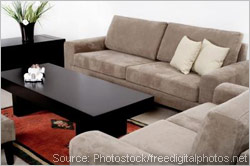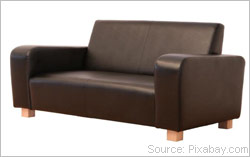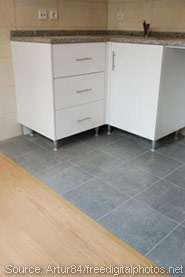
While we all wish we could keep our homes in pristine condition,
there's just one problem--we live there. Normal wear and tear from everyday use,
foot traffic, and occasional accidents and spills can quickly leave your home
looking less than brand new. However, simply keeping up with basic maintenance
and taking preventative measures can extend the fresh appearance of your home's
interior. This guide will give you some great tips on how to keep your home
looking new and beautiful for many years to come.
Furniture
Your furniture is subject to more abuse than anything
inside your home. Drinks are spilled and leave stains, pets claw the fabric and
leave their hair all over it, and extended lounging leaves the cushions flat and
misshapen. However, staying on top of your furniture's regular care and
maintenance will keep it looking clean and fresh much longer.
Upholstered Furniture
- Vacuum it once a week to avoid the accumulation of dust, dirt and grime that
can leave the fabric looking dull or dingy. Use the special brush attachments on
your vacuum to loosen the hair and dirt particles that become lodged inside the
fibers of the fabric.
- Flip and rotate the cushions on couches monthly. This will keep them from
becoming flat or lopsided and allow for an even distribution of wear and tear.
They should also be fluffed up regularly to maintain their shape. You may want
to take them outside and beat them a bit to shake out any extra dust or dirt
that the vacuum didn't suck up.
- Limit eating meals in the living room. The less spills that occur, the
longer your furniture will stay looking like new. In case of a spill, always
blot, never rub.
- Have it professionally cleaned once every year or two. Furniture cleaners
will come to your home, deep clean your furniture, and spray it with protective
coating that guards it against spills and stains. You may also opt to take your
cushion covers to the dry cleaners--but you should never wash them in your
washing machine. This can cause fading, shrinkage, and fabric
deterioration.
Wood Furniture
- Keep the humidity around 40 percent. The air in your home can greatly affect
the condition and appearance of your wood furniture. Use a humidifier in the
winter months to keep your pieces from drying out, and a dehumidifier or air
conditioner in the summer to keep wood from swelling and expanding from
moisture.
- Wash wood periodically with non-alkaline soap and water. Use a soft cloth or
sponge to remove old wax build-up, then dry right away. Leaving it wet can cause
marks and damage to the wood.
- Keep away from heat and sunlight. Placing wood furniture near radiators,
windows, fireplaces, and heat vents can all cause damage to the wood.
- Polish with paste wax twice a year. Apply the wax with a soft cloth and rub
gently in the direction of the grain.
- Always use coasters, placemats, etc., to prevent water damage and spills.
- Use mayonnaise to remove water marks. Rub about two tablespoons of
mayonnaise over the mark, then cover lightly with a cloth or plastic wrap for
several hours. Remove all traces of mayonnaise with a cloth, and your water mark
should have completely disappeared.
Leather Furniture
- Keep it away from sharp objects. Leather is easily punctured or torn by
points and rough edges.

- Keep it away from direct sunlight and heat. Your leather furniture should be
placed at least two feet away from any heat source because it will cause the
leather to dry out and become brittle. Excessive sunlight exposure can cause the
colors to fade over time.
- Clean the leather weekly with a soft, dry cloth and mild soap and water.
Keep the cloth only slightly damp and rub lightly to remove dust, dirt, oils and
crumbs. In case of a spill, blot the liquid immediately before it has a chance
to soak in. Always clean an entire cushion evenly and not just one small area to
prevent spotting. Wipe dry with a clean towel.
- Apply leather cleaner about four times a year to keep it from
cracking.
Carpets
Carpets sustain a lot of punishment--trampled by feet,
crushed by heavy furniture, and dirtied by mud, pet stains and food spills.
Careful care will keep your carpets clean and luxurious and greatly enhance the
appearance of your home.
- Vacuum carpet regularly. Frequent vacuuming prevents the buildup up dirt,
dust and debris that can become embedded in the rug fibers. Soil can scratch and
pit the fibers of your carpet, so vacuuming often will help maintain its fresh
appearance. You should vacuum high-traffic areas of your carpeting at least two
to five times a week, and low-traffic parts about twice a week. Use brush
attachments suited for the height of your carpet to prevent damage to the
fibers.
- Trim snags. Those little tufts that pop up in your carpeting when it becomes
snagged on something sharp can make it look old and worn. Never pull at these
threads--it will only make them worse. Instead, trim them carefully with
scissors.
- Fluff up dents. Indentations can form in your carpeting from the placement
of heavy furniture. If you decide to rearrange your set-up, you may be left with
unsightly impressions on your rug. To fix, simply moisten the area with a damp
rag, then heat the spot with a blow-dryer. Never touch the blow-dryer to the
carpet--hold it just above the surface as you rake the carpet fibers with your
fingers.
- You should shampoo your carpets every 12 to 18 months. Move all of the
furniture out of the room and vacuum to pick up all the loose dirt and dust.
Then, fill your carpet shampooer with shampoo and move slowly back and forth
over one four- to five-square foot area at a time. Be careful not to let the
carpet become too wet. Allow it to dry completely before moving your furniture
back.
- Spot clean stains when they occur. Use stain remover sparingly and blot
stains-- never rub or you can damage the fibers. Make sure any detergent is
removed thoroughly after cleaning, or it will cause its own stain.
Tile
Ceramic tile floors are elegant yet fragile. They must be
delicately cared for to prevent permanent damage and maintain their beautiful
appearance.

- Use doormats. Dirt and mud tracked inside the house on your shoes can
quickly make your tile floors look filthy. Shake out your doormat regularly.
- Sweep your tiled floor regularly. If dirt and dust is not eliminated from
its surface often, it can become very difficult to remove. You can use a vacuum
and the appropriate attachments as well, but make sure there's no beater
bar--this can scratch your tile. To wash your floor, use a warm, damp mop and
tile cleaner.
- Seal the grout twice a year to prevent it from growing noticeably black and
dirty. In between sealings, clean grout with a toothbrush and an even mixture of
water and hydrogen peroxide.
- Avoid plain soap, vinegar-based cleaners, and scouring pads. Regular soap
can leave a film on tile, and vinegar can make it look dull. Never use scouring
pads-- they are very abrasive and can scratch your tile.
Hardwood Floors
Hardwood floors are stylish and chic, but
perhaps the most difficult type of floor to care for. Preserve their natural
beauty with these simple steps.
- Make sure that the floor's finish is fully cured (seven to 90 days depending
on the type of finish) before placing any rugs on the floor. Otherwise, this can
cause a permanent "rug print" in the finish.
- Always use rug pads under any area rug placed on your hardwood floor. A
dense felt or natural rubber rug pad will prevent damage to the floor and
protect it from pressure.
- Put felt glides on furniture legs. This will keep the floor's finish from
becoming scratched or scuffed if you need to drag your heavy couch or table
across the floor.
- Wipe up spills swiftly with a dry cloth or towel to prevent water damage to
your wood. In case of sticky or dark-colored spills, use a towel lightly
moistened with plain water and then quickly dry with a clean towel.
- Be careful with high heels--if they are not properly maintained and the
steel support rod is protruding, it can cause deep scratches to your hardwood
floor. Keep all high-heeled shoes repaired regularly as a preventative measure.
- Vacuum, sweep and mop regularly. Never use a vacuum's beater bar--it will
scratch the floor and damage the finish. Beware also of vacuum wheels--always
move any cumbersome items across the floor with care. It's best to lift your
wheeled vacuum to relocate it to a new part of your floor rather than drag
it.
Other Tips
- Clean and replace your home's filters monthly. This means your furnace,
stove hood, air conditioner, and dryer vent.
- Inspect windows and doors for draft-causing cracks and replace seals as
needed.
- Clean fireplaces and inspect chimneys for loose or missing mortar. Chimneys
should be professionally cleaned once a year.
- Create a file for all appliance instruction manuals and keep a record of all
maintenance and repairs.
- Touch up your walls--any scratches or chips in the paint can be easily fixed
with a little fresh paint. Clean walls regularly with a little soap and water to
remove fingerprints, smudges and stains.